Lendita Zeqiraj (Prishtina, 1972) is a filmmaker today, but she was once a stolen baby, too. Told by doctors she had no chances to survive after birth and there was nothing to do about it, her grandmother, Shukrije, assisted by her brother, decided to steal her out through the window of Prishtina’s hospital and give her an opportunity. Fed by yoghurt and rice water in her first days of life, her blackened skin soon turned to a natural pinkish color. She survived.
Zeqiraj is now in her mid-40’s, and has just finished her ninth film project, the feature film “Aga’s House,” which is currently without a set release date. Her new film is an incredibly mature production that speaks to the heart of human struggle, from the rawness of the instincts of survival, through the tough humor she already pulled out in her latest short, “Fence,” which was recognized by several Oscar-qualifying awards.
At her house in the center of Prishtina, the filmmaker makes it clear that she’ll let few obstacles stand in her way. “I don’t think I cannot do something, or [worry about] whether I know how to do something. I just do it, I learn how to do it by doing it,” she says.
Her house is a testament to that, several elements of which she has built herself, by hand, including a beautifully symmetric sink, lights and walls. Her attention to detail at her own home comes as no surprise when analyzing her films, each one more skilled than the previous.
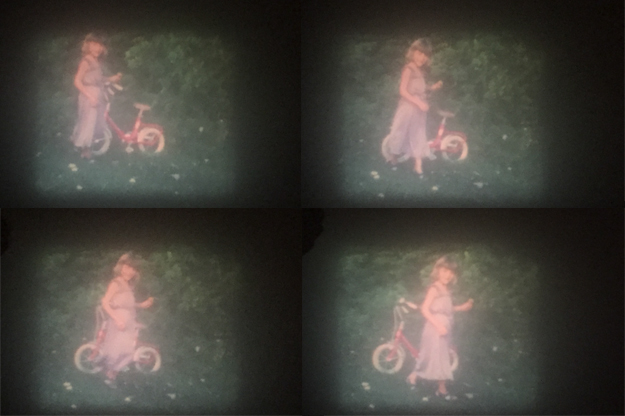
Lendita Zeqiraj was introduced to film at an early age through her father’s Super 8. Photo: Still from an old film from Zeqiraj’s childhood.
Zeqiraj’s cinematographic career began in the early 2000s, her first film, “Exit,” she directed alongside her sister, filmmaker Blerta Zeqiri (“Marriage”). Much of Zeqiraj’s first decade in filmmaking was spent in France, where she lived for 10 years. But back in Kosovo, her short film “Balcony,” a satire depicting the true life of a neighborhood in an apparently dramatic but inofensive situation lasting less than 20 minutes, set her out in the film scene as one of Kosovo’s more forward-thinking filmmakers.
No longer a newcomer in her field, Zeqiraj has brought a new voice to national cinematography.
In “Fence,” released earlier this year, Zeqiraj broke her almost five-year creative silence. The short, a single 15 minute uncut take, provides an uncensored and uninhibited look into the lives of a group of women sharing a living room, while a young boy (Art Lokaj) strives to gain the attention of his mother. It is through Zeqiraj’s scripts that the audience comes to understand the characters, real women, and real men too.
After a successful year, and ahead of her new release, “Aga’s House,” K2.0 sat down with Zeqiraj at her house, to view and review her latest productions, speak of her relationship with actors, family and filmmaking, and the treasures of time and detail.
K2.0: Until now we’ve known you mainly through two short films, “Balcony,” and “Fence.” What prompted you to finally make a feature?
Lendita Zeqiraj: Actually, I started to make films in 2002. We started with my sister [film director Blerta Zeqiri], and the first film that we made, “Exit,” we did together. After that, I was doing a few documentaries for Al Jazeera, like “We are not in Paradise.” They were 50 minutes, and for me it wasn’t [a matter of] doing feature, or a short film, it just fit to this idea.
After that, I was doing some experimental things, I don’t know why. Recently I reviewed an experimental three-minute film I made in 2010, “Amnesia.” And I saw it [in my house] on the big screen, and I didn’t know why I did it, but it just felt different from the memories I had while I was doing it.
I didn’t realize why I was doing it at the time, and now it was a bit clearer. I was going through motherhood, exploring that experience and my relationship to it, to my son, to my mother. It’s made out of Super 8 films of my father, he had a Super 8 camera and a projector, and after the war we found the material from the Super 8. In a lot of the film there is me when I was just five. And it was like some totally different reality.
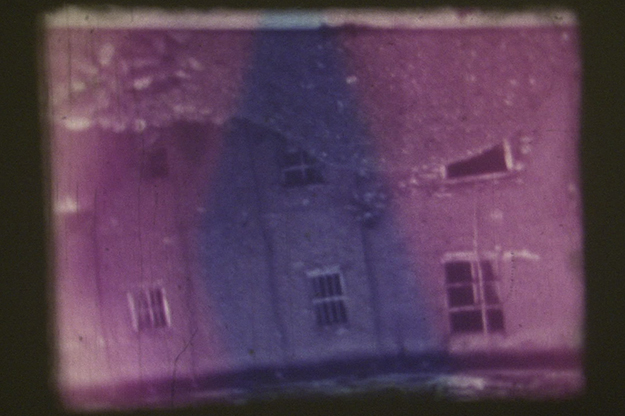
In 2010 Zeqiraj used her father’s old films to produce an experimental short, “Amnesia.” Photo: Still from “Amnesia,” courtesy of the artist.
Maybe there was something I wanted to express, but I couldn’t express it through painting, through films, through dialogue. It was a soundless film, and to me, it was like a lot of paintings, and I collected them. The naming, “Amnesia,” it’s because it gave me the sensation. Everything was somehow blurred, and I played with the focus. Only from this moving image, somehow we can imagine things, but we don’t know really.
From what you’re describing, painting seems to have influenced your filmmaking. How?
A lot. I’ve been painting almost all my life and from the beginning, as a painter, you have this white canvas, and it is in a frame, so you have to put whatever you think, feel, want to express, there. You have this limited space, and it was very difficult for me to put all this there, but it helped me a lot because I taught myself to reduce, and maybe this is minimalism… Even in films I try to make this through this space [which in films becomes] time. All my films are very limited in time. And there I can put everything, whatever I want. But it has this kind of limitation, and maybe this is why I choose them. Then there are a lot of elements and I can play with them.
“Balcony” and “Fence,” are both around 15-20 minutes of real time, and the feature [“Aga’s House”] is like 4 hours of real time condensed into almost two. Until now, I hadn’t thought of this limitation, but I think that to make something you have to have some sort of pillars. This is a stable base to build upon, and I think this is what I have in film.
Have you experimented in developing a script in which time was not the pillar upon which you created the film?
I put this ‘time’ condition as a challenge for myself. To me, it’s very important that, if you can say a lot of things with few words, then it is much better than using many. It’s the same with time. This was some sort of challenge that I put in front of me, and then here I have these limits, and I want to express my ideas, and feelings that also come from a long time ago. But then you have to have space and time to make films, especially.
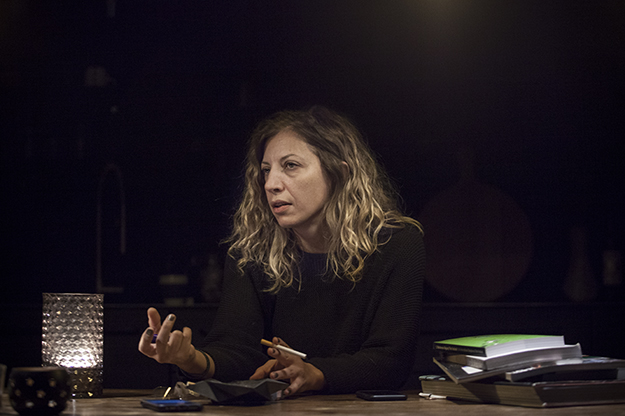
Zeqiraj’s most recent films have been characterized by having a short realtime duration, long dialogues, and no room for improvisation. Photo: Majlinda Hoxha / K2.0.
Does it limit you in any way? Do you ever feel that this way of making films, with this time concentration, has limited the possibilities of the story? Did you feel the need to try something new?
I’m trying this for my new film. I want, on purpose, to break this time idea. But I always go back to that. I don’t want to make it differently if I can do it in this way. There has to be a reason. A real reason, to have time prolonged.
There is also a very ‘theatrical’ style in the way everything happens, in the way characters are presented and interact in the space. Do you take inspiration from theater in your script writing and filmmaking?
During the writing I don’t really think of techniques. There are these characters that somehow start to live with me, and I just need to give them words to talk. They are existing and, really, I’m just catching the moment of those characters that I created and that are now real and exist.
Technique always comes after for me, just before the shooting. From the beginning when I start to write, I know where the characters are. And that’s what I make. I also do production design myself, for all my films, because I just know how and where they are, what kind of glasses they have, how they look, and what kind of costumes they wear, and everything. They are there, and I just have to describe them for the costume designer, and the actors.
I don’t think there is something really related to theater because I haven’t seen much theater. I don’t really go often to the theater, so I don’t feel attached to it.
When it comes to developing the characters and the script itself, there is a strong intensity throughout the film. The plot often keeps the viewer engaged throughout the whole story. The way you use time also adds to that. When it comes to the text, how much space is left for actors to add their own improvisations in bringing the script to life? How do characters continue to develop throughout the filmmaking process?
From the moment that I write the script, somehow the dialogue cannot be changed. I don’t know, it’s just there, and it should be like that. Then I work individually to try and put this character within the actors. I give them a lot of tips so they can understand what kind of character they have, so they can understand the character better — they have to find [the characters] in themselves.
"Somehow you create this kind of magic, and you create a new reality that doesn’t exist — you’re creating it with a lot of people who believe in it."
We are all so different, we can find anything. If I want to develop a character that is bad, I have to find this badness in me. And sure, everyone will find it, a little or more. This is how I work with actors. Sometimes we need to work more with some of them, it depends on them too.
From the moment I feel that this actor has it, and they start to think as the character in the film, then we start to work with dialogue. If there is one word that we cannot do as per the script, we may replace it, but we stick to it. It has to stay like that. The work with actors is really not with the script or the dialogue, it’s more between two people. For me, it’s trying to understand the actors, and their character, and trying to help an actor embody a character.
This must create a very close relationship with the actors.
It has to be, and it has to be also this relationship between actors [themselves]. It depends if they are friends or not, what relationships they have, but yes, this is really what I love. Somehow you create this kind of magic, and you create a new reality that doesn’t exist — you’re creating it with a lot of people who believe in it.
After establishing this kind of relationship it’s very easy to direct them. Really easy. For the feature, we started to work around two months before the shooting. While doing that, we were always talking about many things, including private life. This is how I think you get connected to the actors. Actors have to connect with you, and trust you, and without that it’s not possible to work [together].
Working with the actors so much, and given how important it is for you, do you work in discovering new actors too?
Yes, Rozi [Rozafa Celaj] for example, came out this way and acted in “Fence” and in “Aga’s House.” She had never done acting before. When I asked her whether she wanted to be in my film, she was like, ‘Who, me?! But I’m not an actress, I don’t know if I can do this.’ And I said, ‘Yes you can.’
She was doing film directing at the university, but I knew her as she was a friend of my son, and I said, ‘She can play.’ I liked her, and I knew she could give something interesting to this film. I just took her like this. In a lot of films, this is one of the challenges in my work with actors. I really like to work with them, and to discover them. It’s challenging to work with someone who has never worked before as an actor. You start from the beginning.
There is a lot of pre-production and planning that goes into the technical aspects of the film, and your scripts. Often, it comes across as being spontaneous, but there’s a process and thought behind everything that escapes the viewer.
Technically, “Balcony” was easier. In “Fence,” there were technically three locations, the garden, the road in front of the house, and the living room inside the house. This was a challenge, and we did 28 takes. In the end there is only one choice of one take among all of these [as there are no cuts]. We recorded at the time when the light was coming down because I was interested in this time when the light is falling, in the twilight. The light changes and it’s sad not to see the change of light when you have only one take.
"It's challenging to show a reality that is tough, or that is bad, violent, especially in art and films. But if you want to bring it to the audience, and if you want the audience to accept it and to be open, you have to do it with humor."
It also has a meaning, the fact that it is at twilight, the film. In some ways, each film has its own feeling. Somebody in them transmits hope, everybody has something to transmit. And these characters [in “Fence”] don’t have strong hopes.
I resist the idea that there is no hope, because I don’t want it to be that way, I’m fighting, but at the same time, I know now it is the way it is. We, as people, everywhere in the world, we’re going in a very different direction. Values are changing, there are wars, there are walls being built, and people are applauding presidents who build walls. For me this is all nonsense.
In “Fence,” the characters, who are mostly women, are laughing about being hit by their husbands, their stories are pretty raw. What stories and approaches did you feel were missing in other films that you wanted to bring to life here? These are real stories of women, mainly.
This is somehow the normality of being for these women, they grew up like this, and the majority, especially in the region of the Balkans, they are born as female, as girls, they endure lots of things, a huge majority of them. From the beginning, they are taught to listen to their brothers, and always someone else is choosing for them and for their fate. In the film, somehow, they are not self-censoring. They think they are doing the right thing, and having fun with it. It’s somehow a way to manage this violence, and being in this violent society.
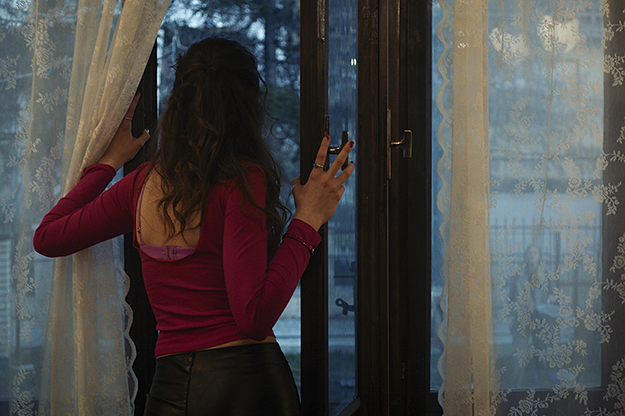
In “Fence,” a family gathers in a chaotic living room, giving life to a dialogue that reflects a mix of generations and life expectations in humorous and raw ways. Photo: Still from “Fence.”
Without giving away any spoilers, “Fence” depicts stories of three generations of women interacting in the same space. The younger daughter seems to be dating a foreigner (something her mother does not seem to like). The younger girls have fun, and they make fun of the older ones, who are more stuck in their tradition. Is this meant to be a representation of the Kosovar youth?
Youth in general I think, maybe the Kosovar one because I know the youth better here, but I think everywhere is the same. When the film was screened in the U.S., or in Switzerland, people were all relating to the characters, to the story, because, even in Switzerland, and everywhere, they are dealing with racism.
I was a bit surprised when the film was in Palm Springs, and people were telling me “OMG, it was like being at my aunt’s house!” It was surprising how people can relate to this story, but it’s a human story after all, it’s not ‘Kosovar.’ And I think this clash of generations, the mentality about borders and races, is the same everywhere. Here, maybe they can endure it, manage it with humor, make fun of it, but they have these [experiences] everywhere, so [many people] can relate to all of these problems.
Humor is also very present in your latest films, and it’s always a humor that makes fun of the struggle. Sometimes people refer to it as ‘Albanian humor,’ and it’s important to understand the culture, and the lifestyle, to understand the humor. Of course culture influences how we speak everywhere, but humor reflects culture at another level. These are tough, raw stories, told through laughter, at times. Is it easy to bring this humor to the audience, at home and internationally?
It’s not very easy. Showing a reality that is tough, or that is bad, violent, [is challenging], especially in art and films, but if you want to bring it to the audience, and if you want the audience to accept it and to be open, you have to do it with humor. Otherwise they will shut down and be like, ‘It happened to someone else, but not to me.’
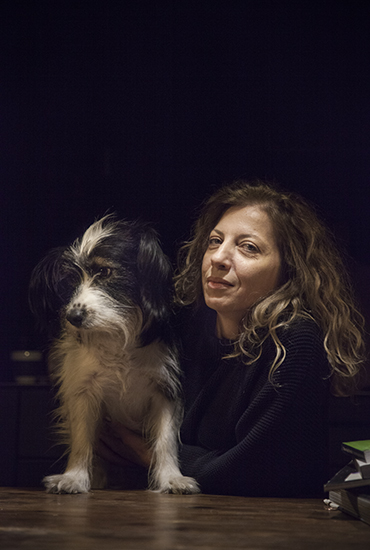
After recording “Fence” with canine star Nina, a stray dog taken from the streets for the film shooting, Zeqiraj adopted the dog and they became new life companions. Photo: Majlinda Hoxha / K2.0.
I think about what I would like to see [in a film], and I would like to see something that makes me feel, cry, and think. These are not criteria, but it is something that I look for in a film. And I don’t think that the audience is less intelligent than me, I think the audience is always more intelligent than me, so I have to be careful and give them the maximum that I can give. I know that some people will say, ‘Let’s explain this because the audience won’t understand.’
Many films that I see here explain a lot, and the information is forced. And whatever is forced, is putting you as the viewer in a position where you realize that certain information has been put there so that you understand it. That way, you can see that it’s just a film, and you cannot enter the story and be with the characters, and feel with the characters.
In a former interview with K2.0 you said, “I don’t create as a woman, I create as a director. There is only one vision, which is the artistic vision.” But you are a woman. Maybe because there have always been more men in scriptwriting and directing in Kosovar films, there are many more male protagonists, and even when there are stories of women, or on the other hand, of violence, of sexuality… the perspective portrayed is the perspective of the man. With more women in film production and direction, how do you think films are changing? How are more women in film affecting the stories, the characters, and the representation of women? How do you reflect on this?
In Kosovo cinematography, until this last five years that we started to make more films, no woman had a budget to make a film. And the character of a woman in film before was that of a victim. It was a mother, often a male character had a mother who had no sexuality, or a sister, or they were victims.
Mother, sister, victim, these are often three molds [that women characters take]. And they all go together. I don’t want to generalize, and I know men who know women really well, but the majority of them don’t. They don’t know their mothers, their sisters, or even their wives.
"You don’t have one role in life. You exist with a lot of roles."
And of course, female and male characters have differences. They have different backgrounds. Every human being is different from another, and males and females have their differences, even if we don’t want them to have them.
Whenever I saw these films from the past, it was something so unreal. So fake. I had so many problems with the characters created for women in film – they are not real. That’s it. I can say victim, or mother, whatever, but they just weren’t real. A mother in a film is also a woman, is a neighbor, someone who walks in the street and has problems…
You don’t have one role in life. You exist with a lot of roles. It was so important for me to show who we are, how we feel, how we think – not because we are women but because we are human. And until now nobody has shown women’s sexuality in film, it was denied to them.
Then, to create a character, a real one, you have to know this character very well, from its birth, to parenting… I know my characters, I know their background, their family, their struggles. I have to know them. A lot of people told me that my characters are real, and they are before I start to write. Ask me about any and I will tell you who they are.
In “Fence,” we see the character played by Adriana Matoshi as a very silent one, but she seems to be going through a lot that we don’t fully understand, but that you can tell is there. What’s her story?
She’s from a good family. Her mother and father are educated, she was always someone who listened and wanted to please everyone in her family as a kid. She grew up and found the love of her life — she thought she found it. Because she doesn’t want to disappoint the family and neighbors, she marries, they have kids…
But she is so unhappy because her husband is probably cheating on her, he treats her like shit, he beats her, but she has to forget everything, be silent, and she cannot even complain to her sister. Her sister, who is played by Ilire Vinca, is more [outspoken], and so she doesn’t have attention. She cannot be a model for her kid, to listen to him, she’s in real bad shit without hope for a better future. Her state of mind, her intelligence and her will [went away] long ago, and she is now just waiting for her death. It’s very dark. But this is her character.
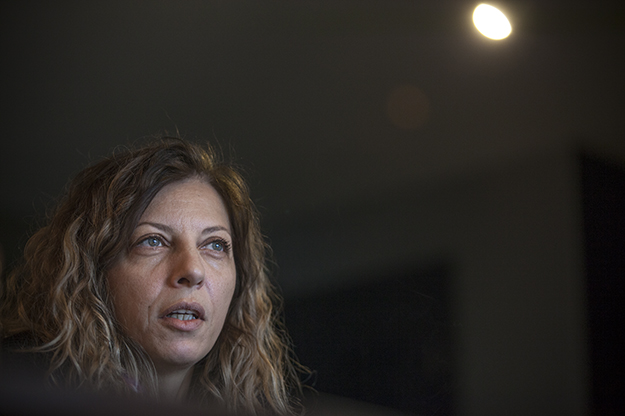
Lendita Zeqiraj says that she can hardly find characters in Kosovar films that are “real.” On that note, through her newest films “Fence” and “Aga’s House,” she has built characters that truly tell a story, without silencing others. Photo: Majlinda Hoxha / K2.0.
The character of her sister is very different, she is outspoken, angry at her daughter who is joyful, a bit of a ‘rebel’ maybe, and she keeps complaining about her mother-in-law, to whom she is obliged, by culture, to commit and be loyal. What’s behind that dynamic?
Her sister is very different, she’s older, maybe as a bigger sister she has more character, she’s more of a fighter, but even the fighting has limits in a Kosovar family, or in these kinds of patriarchal families. At least she can complain, and she complains about her husband, but she stays. In the same way, she is giving the same violence to her own daughter. Whatever she inherited, she is also passing it on to her daughter, because “this is the way it should be.” This is the limitation — ‘gardi.’ The fences.
The only one who wants to challenge this is her daughter, and maybe we can hope that she will go beyond ‘gardi,’ beyond the fence [that surrounds her house], but we don’t know. It depends on her strength and her ability to go further.
“Fence,” which, except for the two boys, includes no male characters, is filmed in the private sphere, which is also the one that we rarely get to see outside of the family. There is a separation between the public space and the private. Is that intentional?
I wanted to bring the viewer to the cell of the family itself. All society is structured in this family cell, and in that cell they speak out loud, they preach. They are real in this space.
What do you think has changed in the past few years for us to be seeing a larger number of women making films, as writers and as directors. Kaltrina Krasniqi, with scripts by Doruntina Basha, Blerta Zeqiri, More Raça, you… This influences the stories that are being brought to the screen, at least it seems to be doing so. Do you feel that you are part of a sort of generation? Do you influence each other in some way? What do you think has led to this current surge in filmmaking?
What’s changed is that now we have opportunities to show and to express ourselves in this field. Before, it was not possible. Blerta [Zeqiri] was the very first woman to receive a budget from QKK [Kosovo Cinematography Center] to produce a feature film. We didn’t exist! She received it for “Marriage.”
In the same year, 2012, they gave a little bit for my short, for example “Balcony” was given a budget. But Blerta was the first woman to be given a budget to produce a feature. I know other women who were working maybe on other teams, as assistants, etc.. But now you have a lot of women making their first feature film.
And now we will see. I am so optimistic that we will see some different points of view, and different styles. We are in this new wave, somehow, because we are new in this industry and we are bringing new things that are not related to what we had in Kosovo before.
The stories are so different, the point of view. Kosovo has a lot of real stories to be told. We don’t need to fake them, we have them everywhere. The point is not just to tell the story, because if you want to tell the story you can write a book, if you don’t have this visual storytelling, but directors have to work on the visual element, and on what he or she puts on the screen. They have to find a way to approach their theme.
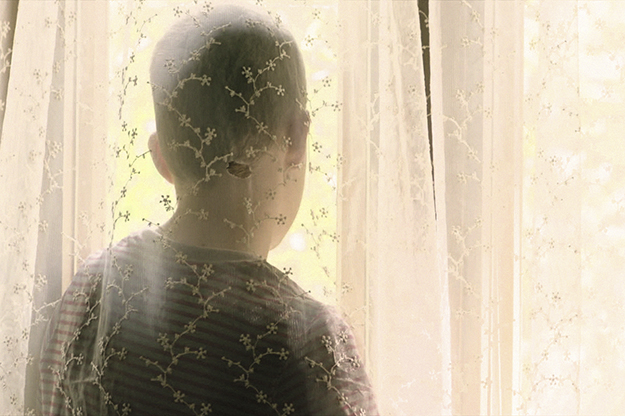
With no release date yet, Zeqiraj’s “Aga’s House” is a determined step forward in her filmmaking that will shake audiences. Photo: Still from “Aga’s House.”
For example, in “Fence” I did this 4:3 format, and to me it was very important to make this and not use a wide [angle] camera because the mentality of these characters is like this; narrow. It shouldn’t be wide. And starting from the point of where the camera will be and how it will go frame by frame in this long take, it’s thought about. Everything has a purpose.
To me, if you want to put someone into this cell, you have to know how to film it, otherwise it will be a mess and you can be detached. You need to find a way to feel it and to be there.
I’m so optimistic, and I cannot wait to see all the films coming from Kosovo, and from women.
I don’t see us as a generation, or as a group that has influenced each other. I [studied] painting here [in Prishtina], and when I went to Paris to live, I [studied] film aesthetics, which is philosophy. I didn’t do any film school, so I was disconnected all the time from everyone, from everything. I was working really alone with my cast and crew.
Blerta is my sister, we are family. And my son, he’s also a filmmaker, but everyone has their own way and their own thing. When we are together we talk about so many things, but we don’t talk about films.
"Kosovo has a lot of real stories to be told. We don’t need to fake them, we have them everywhere."
With my sister, Blerta, maybe we had some influence on each other at the beginning. I had this passion to make films. I wanted to go to film school, I had a talent for drawing, and I wanted to go to Prague and do animation. Back then, we didn’t have internet. I heard Prague was good. I was 18 and I couldn’t, and they said, “You’re very talented in drawing and painting”… So I went into painting and architecture…
After six years, it was Blerta’s turn to choose what to study. She wanted to go into literature, she had skills for writing. And I was like, “No!” They already had dramaturgy, and I was convincing her to go into it. “You go there, and you write scripts, and I do films! Why literature?” For me, literature was nothing. You can write, but why not write a script and make a film?
I kind of influenced her into dramaturgy and then she started to love the whole thing. We did the first film together and after this she came back to Kosovo, I stayed in France, I did these documentaries for Al Jazeera and stuff, she was doing shorts with 9/11 festival, they were giving some budget. And somehow we developed different interests, for films, for ways of treating the topics…
Another thing that people have often said about films in Kosovo is that there are so many films that deal with the war. But have you noticed that films are changing their treatment of this topic, too, and going beyond wartime or the mere violence of it? Is it possible that new films are dealing with a longer period, expanding into the before, and the aftermath in the longer term, the repercussions? Is this something that somehow you also wanted to touch on through “Aga’s House”?
Well, war happened, we cannot delete this, and life is happening. We choose whatever makes us feel or challenges us to feel. It’s really personal, we’re authors, we write our scripts and we direct them. As an author, it’s also about the way you approach this visual storytelling.
In “Aga’s House” we don’t say it clearly, we don’t locate the film specifically. We know there may be some relation to the war. But if you watch the film and you’re from Argentina and know nothing about the war in Kosovo, you can see the film, and you know that something happened in the past, and here we are now. What’s important is the human story, not the historical arguments and facts. This is why the facts are so abstract. It could be any country, anywhere.
So far, you’ve worked a lot with French co-production. Is it because in Kosovo there are still not enough professionals? And what do you think needs to be done so that the industry can get better here?
You don’t have school for camera or sound, in Kosovo. We don’t have this and we don’t have experience, because we don’t make a lot of films, so people can just start to work, and discover, and learn by working. There’s no industry yet. We make one film per year…
"If we want to compete with the world, we have to do it well."
The way that I want to film, technically, is not possible for someone with no experience or with little experience. And in every film, this is my ninth film, I’ve never worked with the same director of photography. It’s always been someone different.
The sound, I try to take the same [people] each time because I’m very satisfied, but with camera, it’s not easy with our budget to hire people from abroad, because it costs a lot, production wise. But I have to do it this way [with co-production], because otherwise we cannot go and film 20 minute takes, or 15 minutes… [because it’s technically very difficult], and even the feature film was filmed in that way. It requires people with a lot of experience in order to avoid problems and not lose days of shooting.
The Ministry of Culture, together with QKK, or I don’t know who, they have to send young talent abroad to study camera and sound, and all the technical parts of the production. This way we could have everything in place that we need and we wouldn’t need to hire people from abroad…
But if we want to compete with the world, we have to do it well.K
This conversation has been edited for length and clarity. The interview was conducted in English.
Feature image: Majlinda Hoxha / K2.0.








